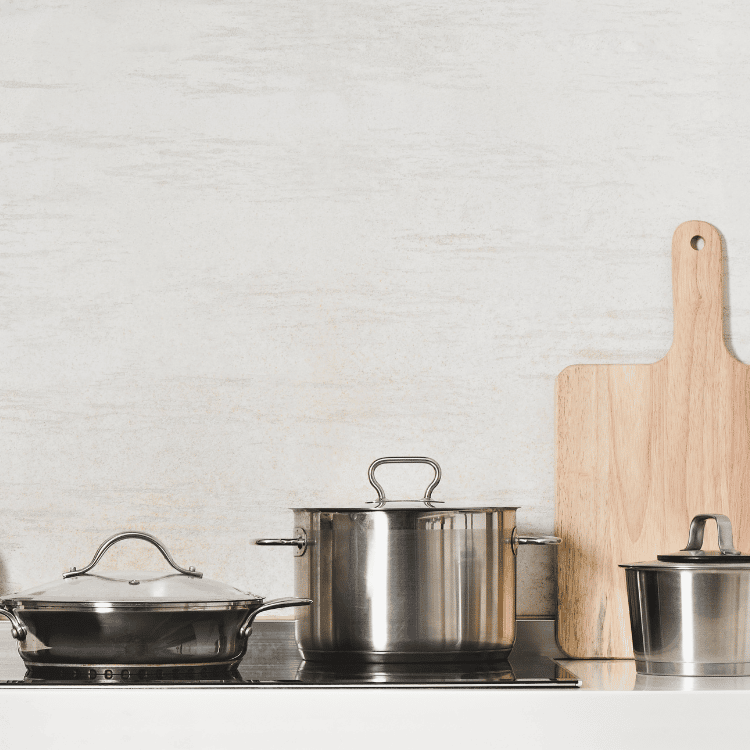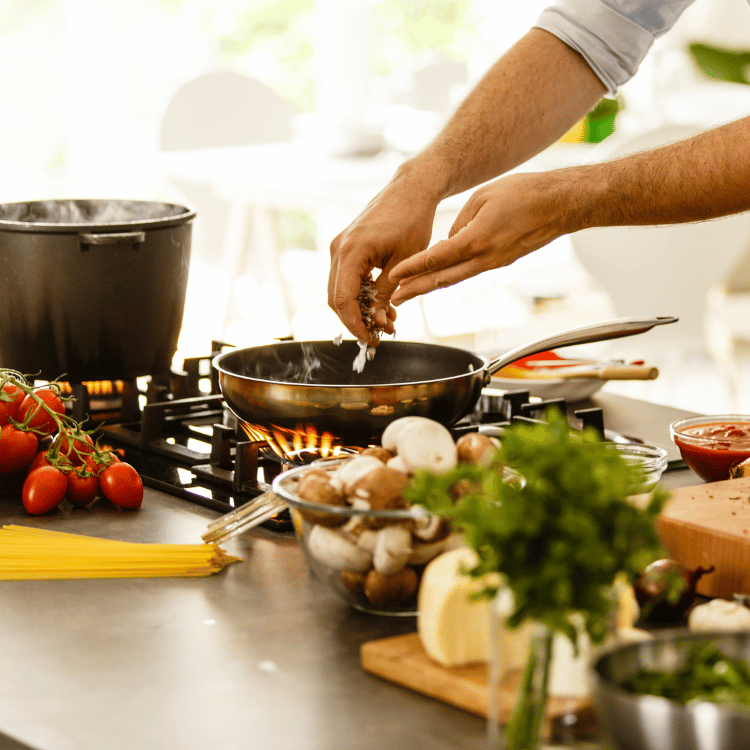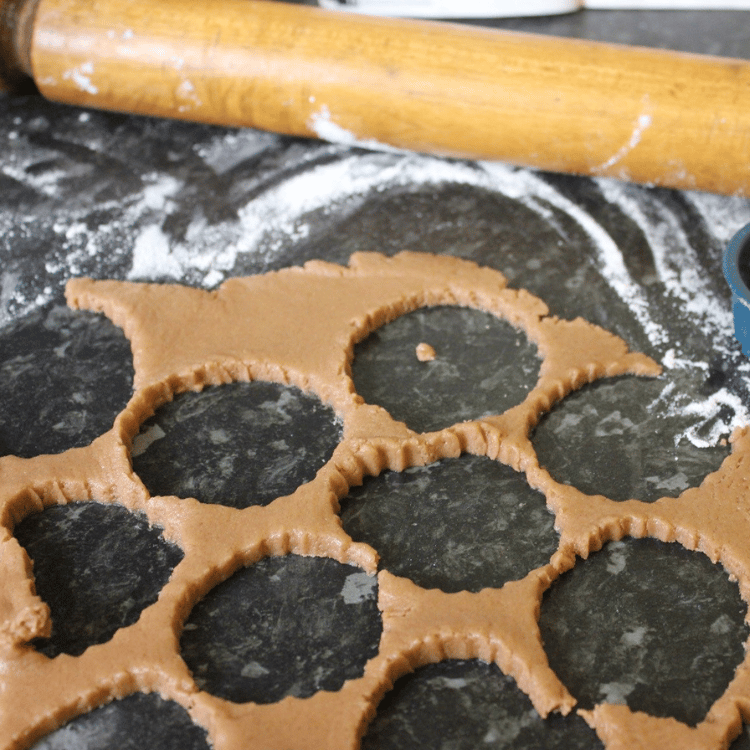

Why cook without oil?
If you are new to a whole food, plant-based diet, you might be surprised to learn that we don’t use added oil in our food. The reasons are plenty. It is a source of concentrated fats void of any nutritional value. When we extract oil from seeds, the nutritional benefits are left behind in the discarded solids. Look at the nutrition label of any oil you use, and you will see no vitamins or minerals in the oil unless they were added, as in fortified oils.
Using cooking oil causes arterial stiffening, impairs gut function, and results in an abundance of calories. One tablespoon of oil has 120–130 calories and 14 grams of fat. It is easy to overconsume calories when you add oil to a dish. It also impairs gut function. Check out this great article by Theresa “Sam” Houghton about why you should dump the oil, “New To An Oil Free Diet? Here’s What You Need To Know.”
When I operated a vegan meal delivery service, my business partner stipulated that I stop cooking with oil. At first, I struggled with this. Oil is not only good for adding flavor to food, it can also be challenging for many people to bake without oil. I spent several months researching cooking and baking techniques to use in my recipes, and I eventually prevailed. The most exciting part of this story is that most of my customers could not tell the difference when I made the switch. I did not announce it ahead of time but instead waited to hear their reaction. The only comment I received was from a client who said that my food seemed less “greasy.” I’ve been sharing my oil-free cooking tips ever since. Here are some of those tips.

Choose the right cookware
Believe it or not, I did not go out and buy a new set of cookware when I started cooking in an oil-free kitchen. Instead, I taught myself how to cook this way using the pots and pans already in my kitchen. There are many types of cookware to choose from, including stainless steel, non-stick, cast iron, enamel coated, and glass. Whichever type of cookware you purchase, it is worth investing in as good a quality as you can afford. When I was in college, I bought most of my cookware from thrift stores. I was often surprised at the quality of cookware that I could find there. Buy cookware that 1) is sturdy and well-made, with strong rivets connecting the handles, 2) has a heavy bottom that disperses heat evenly and holds heat well, and 3) if you are using non-stick cookware, has a non-anodized finish free of Teflon that won’t flake easily.
I have never been a fan of non-stick cookware made with Teflon because, traditionally, it flaked easily and I did not want that in my food. Until 2013, Teflon contained a chemical called PFOA (Perfluorooctanoic acid). It is considered toxic to humans even in small amounts. It was replaced with Per- and polyfluoroalkyl substances (PFAS).* PFAS are still being studied, but the FDA acknowledges that these substances do not easily break down, which makes them a no go in my kitchen. I stick to my tried-and-true cookware (see Chef Del’s Essential Plant-Based Kitchen Equipment for more information about pots and pans).
I have recently started using Silpat, a silicone-based product for baking. It is non-reactive up to 428 degrees, and it works well with most baked goods. Silicone bakeware has been popularized by people like Chef Aj, who first introduced me to it years ago. I was hesitant at first, but I jumped on the Silpat bandwagon recently after seeing that Dr. Greger uses it too. My decision to use silicone bakeware is due in large part to my efforts to reduce the use of single-use storage and cooking materials.

How to Cook Oil-Free
Cooking oil-free is not as difficult as you might think. I have written four oil-free cookbooks, and I teach my students how to cook without oil in every class. Many of my students can recite my oil-free cooking technique verbatim because it is in all my recipes.
Sautéing and stir-frying
Whether I am sautéing vegetables or making a quick stir fry for dinner, the technique is the same. I start with a dry pan and add vegetables with a high water content first. I only add water if the vegetables start to stick to the pan. Vegetables like onions, carrots, and bell peppers do well with little water added, and by not adding water right away, they can brown some, which is one way to build flavor. By not adding water in the beginning of the process, you make sure that water is released from the vegetables, which concentrates their flavor. After these vegetables have cooked as much as I want them to, I add vegetables with a lower water content; spices; and vegetables like garlic, which stick easily to the pan. To see this technique in action, sign up for my cooking class subscription at Live Cooking Classes With Chef Del in CNS Kitchen.
Roasting
Roasting vegetables presents a unique problem in cooking. Oil lubricates food and buffers it from the dry heat of an oven while also caramelizing it. You can roast vegetables without oil, but I am not a fan of dry roasting because it dries out the vegetables. Similar to the oil-free sauté, vegetables with a higher water content fare better in an oven than other vegetables. But there’s hope. A good friend of mine served me roasted vegetables once and they were moist and flavorful. Her secret was to use a mixture of vegetable broth and apple juice, plus whatever spices she wanted to use. I have tried her technique several times with good results, but I prefer to use applesauce that I puree and thin out with vegetable broth. The trick to getting the vegetables to brown is to use as little additional liquid as possible. You want the liquid to evaporate so that the sugars contained naturally in the applesauce can help caramelize the vegetables. Applesauce, unlike apple juice, is a whole food with its fiber intact—always a bonus. Aquafaba (the liquid leftover from cooking garbanzo beans) is another great ingredient for roasting vegetables, especially because it helps spices stick to the veggies.
Deep frying alternatives and the rise of the air fryer
Deep fried foods are full of unwanted fat, but they are very popular in restaurants and home kitchens everywhere. We have known how unhealthy they are for a long time. In my first restaurant job, starting in 1989, we had no deep fried foods on the menu. (Yes, we still used oil in cooking, but it was 1989, after all.)
I still stay away from fried foods, but thanks to the air fryer, I have discovered ways to make delicious foods that are crispy and tasty. Air fryers are nothing more than small ovens with a fan that blows warm air over the food, drying out the surface and making it crispy. They come with a basket that has holes in the bottom so air circulates above and beneath the food being prepared. I was surprised at how well it works. I have made delicious roasted potatoes by first cooking the potatoes (either steaming or boiling them), and then seasoning them before adding them to the air fryer. I have also made crispy corn tortillas in this neat, new oven. If you have a convection oven, you have, in effect, an air fryer without all of the bells and whistles. My first oil-free corn tortillas were prepared in a commercial convection oven long before I ever heard of the air fryer.

How to Bake Oil-Free
Baking without oil comes with its own set of challenges. Oil acts to inhibit gluten development in baked goods, which contributes to a tender crumb that we like in cakes and cookies. It also makes them moist and extends their shelf life, so it is a popular ingredient in baking. I have had success replacing oil with unsweetened applesauce that has pectin in it. Pectin is a naturally occurring ingredient extracted mainly from citrus fruits, and it is used to make jams and jellies. It inhibits the development of gluten in baked goods and adds moisture without impacting flavor. I am still exploring the world of oil-free baked goods, but I do not bake as much as I used to because desserts and I are not on speaking terms, especially as I work toward achieving my health goals.
I use silken tofu to make many dessert sauces or toppings. Silken tofu is good because it takes on the flavor of whatever you add to it. Check out my cooking classes this fall in CNS Kitchen for our dessert class for the holidays. Lightly sweetened fruit purees like berries make delicious toppings for many desserts.
Quick tips for oil-free condiments
It baffles me to see how pervasive oil is in foods. Though it often goes unnoticed, it is even in condiments like ketchup, mustard, or salsa. Salad dressings like mayonnaise are condiments where the traditional use of oil makes sense because it is basically an emulsion of oil, eggs, and vinegar. An emulsion is a technique that allows two ingredients that otherwise would not blend to do so. The oil suspends the other ingredients in it so that you have a creamy sauce. I have been making creamy salad dressings with silken tofu for years. The tofu is naturally creamy and works well to make a number of dressings, both sweet and savory. Check out this recipe for Mayonnaise on the CNS website. Also, take a look at this article I wrote about other ways to make salad dressings oil-free. Many condiments are available without added oil, but you always need to look at the ingredient label to know for sure.
I hope this helps you as you work to eliminate oil from your diet. And I hope you’ll join us in CNS Kitchen and check out our live weekly cooking classes and all of the other resources we have to help you on your journey to good health.
Copyright 2025 Center for Nutrition Studies. All rights reserved.
Deepen Your Knowledge With Our
Plant-Based Nutrition
Certificate
Plant-Based Nutrition Certificate
- 23,000+ students
- 100% online, learn at your own pace
- No prerequisites
- Continuing education credits


